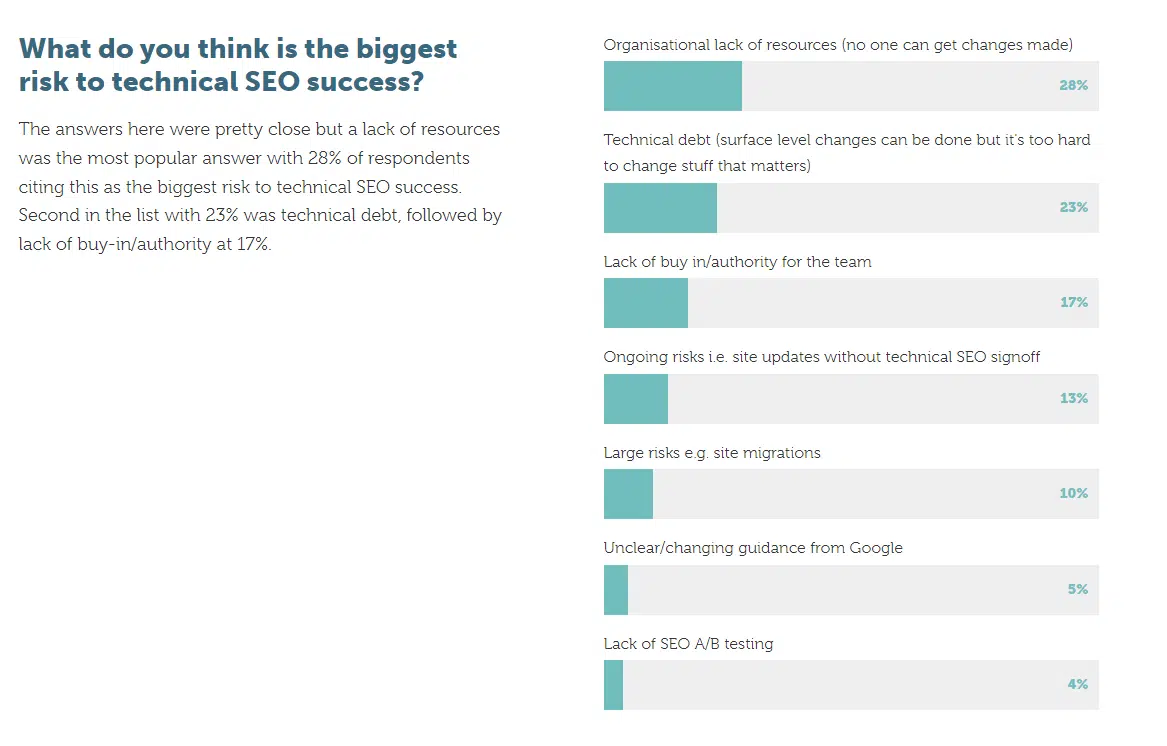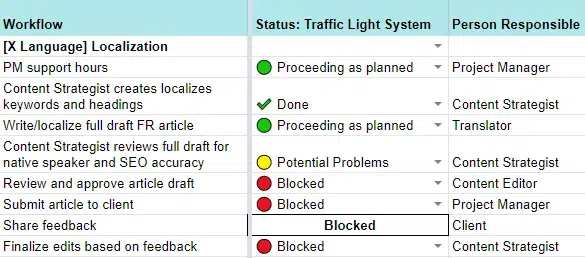How to structure people operations to scale SEO success
[ad_1]
We often hear that SEO takes several months to a year to have an impact.
But that’s not entirely true.
Technically speaking, results are possible within days if you get content live and indexed quickly.
But ironically, that’s often the part that gets stalled.
Things just simply don’t go live – sometimes for months or even years.
In the marketing era of “do more with less,” SEOs have more pressure than ever before to generate impact from the work they do.
So that means content go-live and regular technical SEO updates happening efficiently is an absolute must.
That’s where operations become the key to success.
With structured operational processes, you ensure that you have the maximum impact with minimum time and resources.
To help you achieve this, let’s explore how to structure people operations to quickly and effectively scale SEO success.
The biggest roadblock to scaling SEO: People operations
The biggest roadblock to scaling SEO isn’t the technique itself. Instead, what takes so long is the operations behind SEO and the process of aligning everyone.
People tend to disagree on what content is produced, how much content needs to be produced, who gets a say in editing, etc., which immensely elongates the entire process.
To make things even trickier, the biggest roadblock of all is development time. The development team is often a department grab from product or IT, and they end up with task overload.
Because of this, SEO tasks end up low on their priority list, so things just sit there.
The biggest issue that hinders technical SEO progress is that “no one can get changes made,” as evidenced by Aira’s technical SEO survey of 500 SEOs.

The same survey also mentions that technical changes can take up to three months or longer to go live and start impacting traffic.

With these common issues, stakeholder investment in SEO often stalls because “it takes too long.”
But in today’s highly competitive world of SEO, especially with AI, the one who wins is the one with speed.
Nonetheless, speed in SEO doesn’t mean just putting out content randomly (although some might say that’s better than having no content go live at all).
True SEO success involves methodical and highly structured processes poised to impact from the first day SEO is even muttered – actually, long before content and technical updates go live.
Dig deeper: How long SEO takes to work
5 steps to turn people operations into your secret weapon for successful SEO
If you want to get the most out of your SEO efforts, there’s one thing you should be focusing on – the people operations behind it.
Use the following steps to help you turn your SEO team into a secret weapon that grows the business.
Step 1: Establish product-market fit and viability of SEO strategy
I want to start with reviewing product-market fit because this gives you ammunition for ensuring that you’ll get a budget for SEO in the first place.
Attempting to do SEO with no budget or with a lack of people is an easy recipe for failure and resource misuse.
In today’s market, it takes a significant investment to see results. So, before you get started, it’s important to establish the foundation from the get-go.
You establish product-market fit by reviewing whether your target audience needs your product or service.
In the context of SEO, they actively search for your product or service – or at least related topics. You’ll also want to check to see if there’s enough search volume around these topics to generate ROI for the investment in SEO.
You can use SEOmonitor to forecast the results you can expect.
To give you an idea, here’s a quick example I created for an ecommerce company that wants to expand into Germany.
I checked the SEO impact of optimizing and localizing 30 primary product category pages:

These pages would generate 312,000 more organic traffic to their website and over 30,000 additional conversions within a year once content is live and ranking. Compared with the average order value (AOV) for their products, this SEO investment is super worth it!
Dig deeper: Use this SEO forecasting template to gain insights
Step 2: Ensure management provides enough resources by forecasting results
Use your forecast to try and determine how many resources you’ll need compared to how much ROI you’ll generate.
When you show an estimate of the ROI, management is much more likely to give you the resources you need to do SEO well, including a full team and the tech required. And when you have those crucial resources, you’ll be able to generate results more quickly.
Here are a few examples of calculating SEO ROI for stakeholders, beginning with ecommerce:
| Ecommerce SEO ROI Forecast | |
| Organic Monthly Traffic (based on industry average CTR of 6%) | 6,000 |
| Ecommerce Conversion Rate (conversion rate milestone within 6 months) | 2% |
| Average Order Value | EUR 1,290 |
| Operational Costs | EUR 18,000 |
| Monthly Sales from Traffic | 120 |
| Cost Per Sale | 150 EUR |
| Estimated Monthly Revenue from Sales from Traffic | 154,800 EUR |
| ROI | 760% |
So whether you’ve used SEOmonitor or have estimated an organic traffic growth milestone, add that data to a table like this.
Next, calculate the amount of conversions from that traffic according to your estimated conversion rate multiplied by the average order value.
Subtract operational costs, and then get the forecasted KPIs for monthly sales from traffic, cost per sale, estimated monthly revenue and ROI.
Below is an example of an SEO impact forecast for B2B. It’s slightly different from ecommerce because there is no direct sales:
| Complex B2B SEO Generated Revenue Forecast | |
| Monthly Organic Traffic (across 6 months) | 10,400 -> 13,520 (30% increase) |
| Organic Traffic Conversion Rate (conversion rate milestone within 6 months) | 2% |
| Free Trials / Demos (SQLs) | 270 |
| Average Contract Value | ARR $714M / 11,000 customers = $65,000 |
| Lead to Close Rate | 5% |
| Deals Closed | 13 sales x $65,000 |
| Gross Revenue | $845,000 per month |
In this case, you would follow a process similar to ecommerce but instead swap out free trials / demos or a contact CTA with sales qualified leads (SQLs).
Average contract value is then the same as in AOV for ecommerce. So, based on the amount of SQLs, calculate how many leads might close and how much those contracts are worth, subtract operational costs, and then you’ve got the estimated gross revenue generated from SEO.
Step 3: Organize project roles and operational workflows
Once you get management on board and your SEO strategy is structured around search intent match keywords and content that builds authority around your products and services, you’ll need to establish concrete roles for everyone involved in the project.
This provides a clear understanding of who is doing what, which creates an operational workflow that becomes an easily repeatable and scalable template.
For example, organize the following roles and responsibilities:
- Project manager: Ensures that the project is on time and on budget by assigning tasks to specific people and sending deadline reminders.
- Content strategist: Creates and manages the production and implementation of the SEO strategy.
- Content writer: Writes the content, typically as a subject matter expert or compiles information from them.
- Editor: Edits and proofreads the writing from the content writer to ensure technical accuracy and adherence to brand ToV guidelines.
- Designer: Creates images for content and wireframes for pages that need specific custom designs.
- Technical SEO: Oversees crawling, indexing, and general site functionality, particularly regarding page speed and UX/UI.
- Developer: Responsible for uploading and creating the web pages based on the wireframes from the designer and input from the content strategist. They also make changes for site optimization based on instructions from technical SEO.
These responsibilities must be turned into a step-by-step workflow with clear deadlines. For ease of understanding, here’s a quick snapshot of a spreadsheet that uses a traffic light system to show project progress statuses and roles, but ideally, this should go into a project management tool like Asana.

Here are some other tips to help ensure this workflow functions well:
- Have a dedicated developer for SEO instead of trying to borrow from the product or IT department. Someone should have a job dedicated entirely to SEO and nothing else.
- Organize one person responsible for editing, as more than that, and it can slow down content production immensely.
- Ensure workflows include website optimization, as much of SEO success comes from the optimization that’s done later. Whether the optimization is for CRO, technical SEO, or content, it’s important for SEO results. Don’t let updates sit and gather dust – get them live and take advantage of that positive impact opportunity!
Step 4: Keep track of budgets within operational workflows
Create a system to track budgets. You should keep track of budgets for specific milestones.
As you can see in the table below, each milestone is first separated by language and then by the person in charge.
It includes due date, status, estimated hours, actual hours, and the total cost for each role.
| Month | Milestones | Date Due | Status | Person In Charge | Estimated Hours | Actual Hours(Total) | Cost | Cost (Total – Formula) |
| June 2023 | SEO Strategy EN | 30.06.23 | ✔️ Done | Project Manager | 10 | 22.96 | €70.00 | €1,607.20 |
| 30.06.23 | ✔️ Done | Content Strategist | 5 | 8.15 | €50.00 | €407.50 | ||
| 30.06.23 | ✔️ Done | Editor | 5 | 0 | €65.00 | €0.00 | ||
| 30.06.23 | ✔️ Done | Content Writer | 1500 | 0 | €0.06 | €0.00 | ||
| 30.06.23 | ✔️ Done | Content Writer | €0.09 | €0.00 | ||||
| June 2023 | SEO Strategy DE | 30.06.23 | ✔️ Done | Technical SEO | 10 | 23.43 | €65.00 | €1,522.95 |
| 30.06.23 | ✔️ Done | Content Strategist | 10 | 5.69 | €50.00 | €284.50 | ||
| 30.06.23 | ✔️ Done | Designer | 3.17 | 3.17 | €38.00 | €120.46 | ||
| 30.06.23 | ✔️ Done | Content Strategist | 10 | 0 | €65.00 | €0.00 | ||
| 30.06.23 | ✔️ Done | Content Writer | 1250 | 1250 | €0.09 | €112.50 | ||
| 30.06.23 | ✔️ Done | Content Writer | 1250 | 1250 | €0.06 | €75.00 | ||
| 30.06.23 | ✔️ Done | Developer | 3 | 3 | €23.00 | €69.00 |
You’ll also want to consider other costs when you’re calculating ROI. These should include technology, profit margin, sales, and CS costs.
Having this data compared with the current KPIs SEO is achieving is the direct information stakeholders need to assess SEO success and whether they’ll continue to invest in it.
Step 5: Create conversion tracking and reporting systems
Have a system for tracking and analysis. This is a commonly overlooked yet absolutely critical component of SEO.
If you want to get more investment in your SEO strategy, you need to prove that the resources required for SEO on an ongoing basis are worth it and are generating results. Essentially, you need to “learn to speak the stakeholder language.”
After a few months of implementing SEO – depending on your sales cycle, content indexing speed, and page rankings – you should see conversions, leads, and even some new sales.
However, to track that this came from SEO, you need to have a system set up in the first place. This should include everything from initial strategy creation through to the sale itself. In doing so, you’ll be better equipped to show that conversions came from SEO efforts.
The best way to do this is to track basic SEO KPIs (keyword rankings, organic traffic, organic CTR, backlinks), engagement, conversion sources, and revenue.
Typically done in GA4 or a CRM, tracking SEO KPIs might look like this:

- Tracking conversion sources:

- Tracking revenue (completed sales like in ecommerce) or potential revenue from leads:

Organize the data based on your specific business and take time to regularly present this data to stakeholders without overcomplicating it.
Having your numbers ready when they ask or even offering them up in advance will create a more positive impression of SEO progress and its impact on the business.
Scaling SEO isn’t about time – it’s about organizing people
The biggest roadblock to SEO isn’t the SEO itself – it’s the operations required to apply techniques and keep them moving forward.
The best way to achieve this is to spend time creating an organized structure of people, their roles, budgets, and action items.
Start by making sure there’s an actual need or demand for your product or service.
Next, ensure you have enough resources to accurately forecast potential results, and then break down the project into operational roles and responsibilities.
Throughout the project, keep track of budgets and create a process to track your ROI that better showcases the impact of SEO to stakeholders and decision-makers.
Remember, scaling SEO isn’t solely about the time spent on the project or how much time passes – it’s about efficiently organizing people to get things live.
Dig deeper: A 5-step framework to scale your content operations and SEO
Opinions expressed in this article are those of the guest author and not necessarily Search Engine Land. Staff authors are listed here.
[ad_2]
Source link





